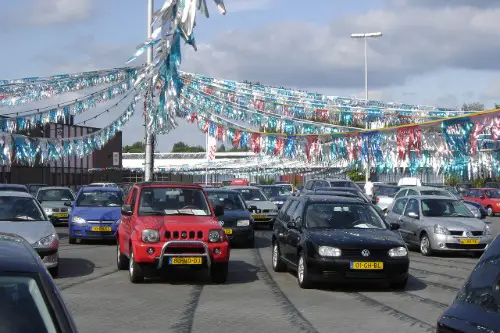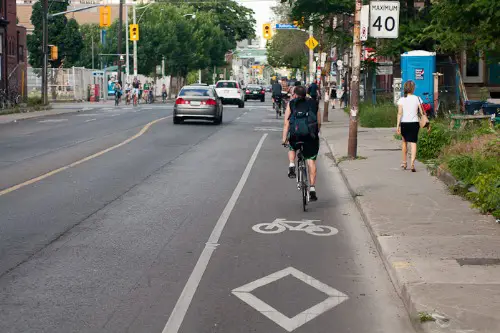1. Eating So Much Processed Meat

Americans love their bacon, hot dogs, and deli sandwiches, and we eat more processed meat per capita than almost any other country. But studies have repeatedly linked processed meats to higher risks of cancer, heart disease, and early death. The World Health Organization even classifies them as Group 1 carcinogens—right alongside tobacco. In 20 years, this might be seen as a public health oversight on par with smoking indoors.
Plant-based and lab-grown meat alternatives are becoming more mainstream and tastier by the year. As they get cheaper and more widely available, the idea of choosing nitrate-filled pork slices might feel gross or irresponsible. It’s not hard to imagine schools in the 2040s teaching kids that regular consumption of lunch meat used to be totally normal. And those kids will probably cringe.
2. Driving Gas-Powered Cars Everywhere

Right now, most Americans still drive gas-powered cars daily—even just to grab coffee down the street. In fact, over 90% of new vehicles sold in the U.S. are still gas-powered. But as electric vehicle technology improves and more cities invest in public transit and bike infrastructure, this routine is going to look pretty strange. People in 2045 will likely wonder why we didn’t switch sooner, especially with climate change breathing down our necks.
It’s not just about the environment—EVs are cheaper to maintain, quieter, and increasingly cost-effective to buy. And with governments setting phase-out dates for gas vehicles (like California’s 2035 ban on new gas car sales), the shift is inevitable. Once charging infrastructure is everywhere and batteries last hundreds of miles per charge, stopping at gas stations might feel like using dial-up internet. Future generations will probably be shocked we used explosive liquids to power daily life.
3. Tipping for Everything

In the U.S., tipping has exploded into nearly every type of service, from coffee shops to self-checkout kiosks. It’s a confusing and often uncomfortable system that leaves both customers and workers unhappy. Most other countries pay service workers livable wages without relying on tips, and many Americans are starting to question why we’re still doing this. Twenty years from now, this chaotic patchwork of etiquette might seem absurd.
There’s already a cultural shift happening, with some restaurants experimenting with no-tipping policies and built-in service charges. If wage laws change and businesses adjust their pricing models, tipping could fade out. Future Americans may look back and wonder why the cost of a $4 muffin came with a moral dilemma and three touchscreen prompts. It’ll likely feel outdated, like using a paper check or answering a landline.
4. Working 40+ Hours a Week as the Norm

The 5-day, 40-hour workweek has been standard in the U.S. for nearly a century. But with rising burnout, mental health crises, and studies showing that productivity doesn’t always scale with hours worked, this model is being seriously challenged. Some companies are already testing 4-day weeks with positive results in employee satisfaction and efficiency. In the future, Americans may look back and wonder why we spent so much of our lives grinding away.
As automation and AI take over more repetitive tasks, the demand for constant human labor could shrink. That means working less without sacrificing productivity—or at least it could. If work-life balance becomes a higher priority for businesses and governments, long hours might become a cultural relic. Future generations might even see the old “hustle culture” as a kind of collective madness.
5. Using Single-Use Plastic Everything

From water bottles to takeout containers to plastic bags, America’s love affair with convenience has led to massive plastic waste. Every year, the U.S. generates over 35 million tons of plastic, and only a fraction of it gets recycled. These plastics often end up in oceans, where they harm wildlife and take centuries to break down. In 20 years, this throwaway culture might seem shockingly irresponsible.
Already, many cities and states are banning plastic bags and straws, and businesses are adopting reusable alternatives. Biodegradable packaging is improving, and consumer awareness is growing. If the pace continues, plastic forks could soon feel like relics from a messier, more careless time. Future Americans may look at our landfills and wonder why we didn’t stop sooner.
6. Taking On Huge Student Loan Debt

Today, millions of Americans are saddled with student loan debt that can take decades to pay off. College tuition has skyrocketed over the past few decades, while wages have stagnated. This system is increasingly criticized as predatory and unsustainable. In two decades, it may seem wild that young people were expected to start adult life buried in five or six figures of debt.
Already, we’re seeing shifts—some states offer free community college, and debt forgiveness is entering the political mainstream. Online learning and skills-based hiring could also reduce the need for traditional (and expensive) degrees. If those trends continue, the idea of paying $200,000 for a liberal arts degree might feel like a bad joke. Future Americans might see it as a form of generational sabotage.
7. Prioritizing Cars Over Public Spaces

Suburbs built around car travel dominate much of the U.S., with wide roads, huge parking lots, and limited walkability. This makes daily life inconvenient for anyone who can’t drive and contributes to pollution, isolation, and sedentary lifestyles. Many other countries prioritize pedestrians, bikes, and public transit—and their cities often feel more vibrant and community-focused. Americans may eventually look back and wonder why they ever preferred asphalt to parks.
Urban planners are starting to reverse course by adding bike lanes, widening sidewalks, and turning streets into pedestrian zones. As climate pressures and housing shortages mount, denser, more walkable communities may become the new standard. This could lead to the end of “stroads”—those hybrid street-road monstrosities—and a rebirth of city centers. The parking lots and freeway on-ramps might someday feel like mistakes of a bygone era.
8. Letting Social Media Shape Teen Identity

Right now, American teenagers are growing up on Instagram, TikTok, and Snapchat—platforms designed to be addictive and appearance-focused. Research shows strong links between heavy social media use and rising rates of anxiety, depression, and body image issues in teens. The U.S. Surgeon General has even issued warnings about the mental health impacts of social media. In two decades, this may be viewed the same way we now look at giving kids sugary cereal and no seatbelts.
Tech regulation is slowly catching up, with talks of banning underage access or limiting algorithms that target young users. In the future, more digital tools may be designed to protect, not exploit, developing minds. Parents might wonder why they ever handed over their kids’ self-esteem to a for-profit algorithm. And teens in 2045 might be relieved that they don’t have to live online to feel seen.
This post 8 Things Americans Are Doing Now That Will Seem Totally Bizarre in 20 Years was first published on American Charm.


